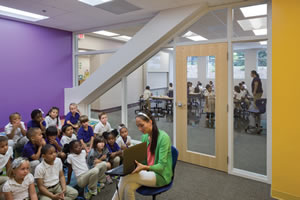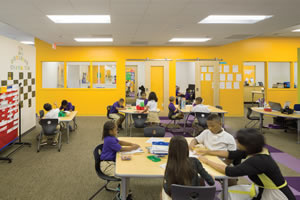Teachnology Tools

PHOTOS COURTESY OF LITTLE DIVERSIFIED ARCHITECTURAL CONSULTING
KISS. Sometimes the simplest solution is the best. For a quick picture this
teacher at Invest Collegiate: Transform Charter School in Charlotte, N.C.,
used her laptop display. For a longer or more complicated presentation
there are other tools are available in this new classroom.
As digital natives and early adopters become
the majority in our teaching corps, the requests for new
and unusual technologies for classroom presentation have
multiplied exponentially. Although our focus on equity in the past
causes many of us to think that every teacher should have precisely
the same equipment in their classroom, there are those administrators
who have wisely determined that each teacher should
have what he or she requests. This approach means that most
classrooms will not have the same tools. Of course, those that are
provided will likely be used.
Control devices make visuals more engaging.
Wireless presenters or remotes are now older technology.
Many were originally designed to advance slides and turn the
presentation on and off or black it out during discussion. Some
were equipped with laser pointers. This tool allowed the teacher/presenter to move around the room while
advancing the slide presentation and
highlighting specific areas of interest with
the pointer. The newest wireless presenters
more closely resemble a universal remote
control. With them you can control the
audio and video on your laptop as you present
as well as advance slides and point. The
cost of these devices is less than $15 and
they interface with a plugin in one of the
USB ports on your laptop or desktop.
There are several ways to engage
students by using visual displays. One way
is to use response pads either as separate
devices, or to use software that allows a
response through a student’s handheld device
(phone or tablet). The research on this
methodology indicates that it tends to coax
answers from even the most introverted
students and therefore increases participation.
No raising of hands or calling out of
answers required!
There are also several devices that allow
a teacher to actively create on the screen.
Wacom makes a digital drawing device
they call the Inkling that allows you to
write, sketch, or draw on any paper surface
and transfer the notes or drawings directly
to a Mac. It costs about $80. Wacom also
makes both large and small drawing
tablets that can be projected on a screen.
Those are often used for graphic facilitation
so that the facilitator doesn’t have to
work with their back to the participants.
LiveScribe makes a smart pen that uses
dot matrix paper to save notes to a tablet
or laptop. Those notes can be attached to
audio clips. The cost is about $130 for the
pen and paper.
Visual display devices
can be portable.
Even in textbook-free environments it
is sometimes useful to display a page from
reference material. Document projectors
are becoming popular for classroom
presentations again. Far more portable
than the old models with the spring-loaded
flatbed that brought the document into
focus, the new models at a cost of about
$70 resemble a small desk lamp that can be
easily repositioned to display documents
on the screen. Pocket projectors for use
with laptops or tablets have been available
for some time, but up until recently
have been somewhat pricey. Some are now
available for around $250. Before you select
one be sure it will work with your device.
Sometimes they exclusively work with
Apples or PC’s and not both. Although not
strictly technology, mobile whiteboards
(the kind you write on with a marker)
often come in handy when an additional
surface is required for projection. Interactive
whiteboards are now the staple of
classroom technology. This is often to the
frustration of the instructional technology
support teams, because as the boards age
they become less reliable on a daily basis.
Several manufacturers are now selling
projection systems that turn any plain
surface like a whiteboard into an interactive
surface. The system from eBeam costs
about $750; the basic system from IPEVO
starts at $150.

PHOTOS COURTESY OF LITTLE DIVERSIFIED ARCHITECTURAL CONSULTIN
Easier Solution. Display and presentation is often a challenge on today’s classrooms. At the Invest
Collegiate: Transform Charter School in Charlotte, N.C., the mobility and flexibility of new technology
for presentations makes presentations easier and more adaptable.
Many science teachers are using digital
microscopes that give the teacher the
ability to display and enlarge images that
were previously seen by only a very few
lucky students. Instead of having to look
into each microscope and focus it and
then letting the student look and hope
that they see the same image, the teacher
can now demonstrate what should be
seen. Of course Video recording can be
done with a GoPro camera ($150 and up)
or a simple webcam (standard equipment
on many devices). For those that prefer
a camera to a tablet or phone, there is
a Wi-Fi enabled memory card for your
digital camera. The Eye-Fi Mobi transmits
pictures directly to your printer or laptop
from your camera. Many teachers are
using digital images of their students to
include in their displays to personalize
the student work.
Accessories can make
classroom life easier.
There are other technologies for the
classroom that aren’t used for the visual
displays, but can be just as useful to the
teacher. From cubbies to science specimens,
teachers always seem to need to label
something. Brother makes a Wi-Fi enabled
high speed label printer that teachers swear
by. It retails for around $90. And speaking
of printers, 3-D printers, once so rare
they were exhibited in museums, are now
making their way into the classrooms and
makerspaces. As predicted, the proliferation
has also decreased the cost. A printer
that requires some assembly will cost about
$350, a plug and play model will be in the
range of $900. For those that prefer to minimize
paper copies there is a lightweight and
portable multi-page scanner that handles
about 12-15 double-sided pages in one gulp
and sends the digital copies to Evernote or
Dropbox. It is made by ScanSnap. Several
teachers have sung its praises because they
no longer have to keep paper copies of forms
at their desk and can easily search for them
on their computer. It costs about $450.
All of the battery powered electronic
equipment will require recharging and
batteries sometimes give out at the most
inopportune times. Many teachers rely on a
power hub as their go-to-device when something
loses battery power. Anker makes a
40w model that has five USB ports for charging
five devices at a time. A mobile charger
is also a handy device. Usually charged
through you laptop USB port, some are small
enough to fit into your pocket. Powerstick+
is one variety. It retails for about $65.
Not every teacher can unpack a piece of
equipment and immediately put it to use,
even though it may have been on their wish
list. Every new piece of technology should
come with two things: personal support
and technical support.
Finally, while it is easy to fantasize from
this list and imagine that the quantity and
quality of high tech tools for classrooms is
likely to be virtually limitless in the near future,
it is very much like an auditorium stage
full of high quality musical instruments but
no musicians. Just as we need talented musicians
to bring those instruments to life, we
need talented educators to make the technology
sing. Watching an effective teacher
orchestrate student engagement through
an expert mix of technology and personal
interaction is still a joy to behold.
This article originally appeared in the issue of .